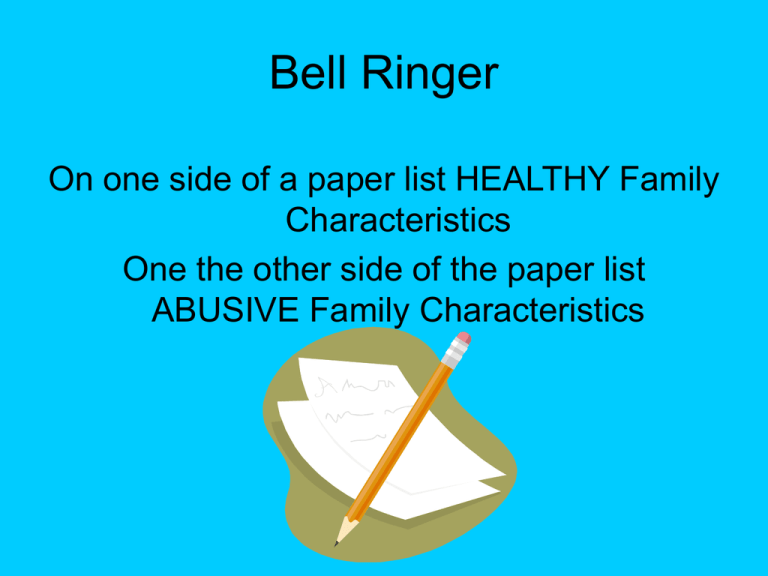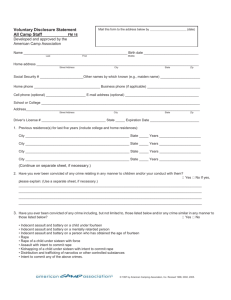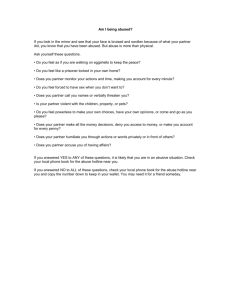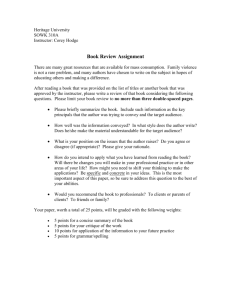
Bell Ringer
On one side of a paper list HEALTHY Family
Characteristics
One the other side of the paper list
ABUSIVE Family Characteristics
Results of abusive treatment:
•
•
•
•
•
•
Rejection results: Lack of worth & self esteem
of normal experiences, no friends, feels
Isolation results: Lack
alone in the world.
Battering results: Fear for safety, no trust
Verbal abuse results: Frightens child, believes world is a
Hostile place
essential stimulation, stifles emotional
Neglect results: Lacks
growth
Sexual abuse results: Corruption of child, loss of childhood
Family Violence & Abuse
•
•
•
•
WHY?
Society portrays an aggressive male as a
desirable trait.
40% said slapping partner is good,
necessary, or normal
Social norms - “spare the rod & spoil the
child”
Social learning model
Why?
Resource theory – male lacks job skills and education so
he resorts to violence to maintain dominant position.
Exchange theory – people will use force because they can
& costs do not outweigh the benefits (hit and abuse
family members because they can).
• Inequality of women
• Private nature of families. Abuse goes down the more
relatives & friends nearby.
• Real-man image. May gain status among peers.
Gender, Power, Stress, Intimacy = multiple causes
Prevalence
There are likely more since many cases are not
reported to police.
• MILLION crimes between intimates each year
(85% female victims).
• 1 MILLION children assault their parents yearly.
• 150,000 men victims of crimes committed by
intimates.
• 40% occur on weekends and in or around
victims home.
• More violence in low-income, low-status families
but anyone is capable of it.
Boundaries
• Boundaries are invisible and symbolic
fences (personal bubble)
– Keeps people from invading our space and abusing
us.
– Keeps us from invading our space and abusing us.
• Experiment
EXTERNAL BOUNDARIES:
• Able to choose our distance, refuse to let others
touch us.
• Keeps us from offending others bodies.
INTERNAL BOUNDARIES:
• Able to be responsible for our own thoughts and
actions without blaming others.
• Keeps us from being responsible for others
actions and feelings.
• Keeps us from manipulating and controlling
others.
Intact Boundary System
Protects self against abuse – physical,
sexual, emotional
These must be taught to children, very
small children have no boundaries.
You usually acquire the boundary
systems used by your parents.
Damaged Boundary System
Can say “No” at times or with certain
people
-But can’t say “No” in certain situations
(dating)
-Or with certain people (authority figures,
spouse, opposite sex, child)
Can set boundaries except when sick,
tired, or scared.
Non-existent Boundaries
Person has no sense of being abused or
abusing others.
Allows others to abuse them without a
clear knowledge that they have the right
to say “No”.
Unaware that abusing others is wrong.
Battering
• Common couple violence: More routine
forms of partner violence that results from
disputes and disagreements.
• Marital Rape: Forced sexual contact by a
husband with his wife; legal definitions of
marital rape differ among states.
Legislation against it in MOST states.
What Do You Think Are Some
Causes Of Spouse Abuse?
•
•
•
•
•
•
•
•
Low self esteem
Abused as a child
Low income
High income
Unable to resolve conflicts
Conflicts over division of labor
Drinking (35-90%)
Wife is more educated
Why do women stay in violent
relationships?
•
•
•
•
•
•
•
•
•
•
•
•
Economic dependence
Religious pressure
Children need a father
Fear of being alone
Belief in American Dream
Pity
Guilt, shame
Duty & responsibility
Fear for her life
Love
Cultural reasons
Nowhere else to go
Are Men Victims of Abuse?
How often are men victimized compared to
women?
Quick Quiz
•
•
•
•
True or False
Women with modern gender-role
attitudes are less likely to leave a violent
relationship.
85% of those raped know their attacker.
Viewing possessiveness as love can
result in date rape/violence.
Sharing expenses on a date increases a
young women’s risk of date rape.
FALSE
True
True
False
The Story of Mary Ellen Wilson
First successful prosecution of child abuse (1874).
http://home.swfla.rr.com/maryellenwilson/maryellen.html
Mary Ellen Wilson
“By April of 1874, nine-yearold Mary Ellen Wilson had
been beaten, cut and
burned by her foster mother
for more than seven
years. She had never once
been allowed outdoors, her
keeper locking her inside a
tiny, dark closet while she
was away. In the coldest
New York winters, the child
slept on a piece of carpet on
the floor, only a threadbare
quilt to warm her.”
“When a concerned social worker named Etta
Wheeler learned of the child's plight, she made
appeals to police, the church, and the courts, but
with no success. "Don't interfere between
parent and child," they said. While others may
have given up, Etta was determined to help little
Mary Ellen.”
“In a desperate last resort, Etta went to Henry
Bergh of the American Society for the Prevention
of Cruelty to Animals (ASPCA). Would this man
who was so kind to creatures help? Surely the
child had the same rights as a defenseless,
abused animal. Bergh heard Etta's story, and
the events that followed forever changed the
course of child protection in America.”
Mary Ellen at age 10,
one year after she
was rescued.
“Out Of The Darkness: The Story of
Mary Ellen Wilson”
Since then a lot has been done to
protect children
• Still 80% of child abusers are parents or
other relatives
• 3 out of 4 child slayings in industrialized
world occur in USA
• 1 out of 3 girls are sexually abused before
they reach age 18
• 1 out of 5 boys will be sexually abused
before they reach age 18
A Rise in Child Abuse
The number of cases of child abuse or neglect reported
to State Child protective Services Agencies rose 65%,
and the number of substantiated cases rose 44%.
Because many cases are never reported, actual incident
rates are much higher.
Risks:
• Child doesn’t match well with parent
(emotional or developmental disabilities)
• Parent under stress
• Little community support (child care or
medical care)
CHILD + STRESS = ABUSE
(Remove child or stress to avoid abuse)
Parental Characteristics
•
•
•
•
•
•
•
•
Abused as child
Belief in corporal discipline
May have spouse violence
Belief that father should dominate
Low self-esteem
Unrealistic expectations of children
Role reversal, uses child to gratify their needs
Unconcerned about seriousness of abuse
Characteristics of Abused Children
• “Normal” but born out of wedlock or
unplanned
• “Abnormal” – low birth weight or serious
illness
• “Difficult” – may be fussy
What is the most common form of
family violence?
Sibling/sibling violence is most common form of family violence
•
•
•
•
•
•
•
Unemployment
Isolated
Low income, economic stress
Unsafe neighborhood
Home is crowded, dirty, unhealthy
Often single parent (overstressed)
One or more family members has health
problems
• Larger family
IS THIS ABUSE?
Discuss with your neighbor whether or not each of the
following situations is abusive.
•
•
•
•
•
•
•
A girl is slapped for screaming at her mother; the slap
stings, but leaves no lasting mark or pain.
A boy is punished in a way that requires stitches.
A mother is careless and spills scalding coffee on her
daughter, who is seriously burned.
A boy’s arm is broken after wrestling with his father
for sport.
A girl is spanked so hard she is badly bruised, but the
father says he did not mean to hurt her.
A child is threatened with a good beating if she
doesn’t clean her room.
A child sees his father violently battering his mother
causing serious injuries.
NEVER Shake a Baby!
Shaking a baby can cause shaken baby syndrome.
Did you know?
• Head trauma is the leading cause of
disability and death among infants and
children.
• Violent shaking is involved in many of
these cases.
• 25-50% of the American public does NOT
know that shaking an infant can cause
brain damage or death.
• Up to 5 years old but mainly in 1st year
Soothing a Baby
• TOUCH: Cuddling,
swaddling, warm
water bottle, warm
bath
• MOTION: Rocking,
walking, stroller, car
ride, rhythmic patting
• SOUND: Rhythmic
chants, ticking clock,
singing, recording of
heartbeat or womb
sounds
What are the 4 types of child
abuse?
• Neglect
• Emotional
• Sexual
• Physical
What are some signs of each?
What is the law concerning child
abuse?
UNDER UTAH LAW,
EVERYONE HAS A
LEGAL OBLIGATION TO
REPORT SUSPICION OR
KNOWLEDGE OF CHILD
ABUSE!!!!
It is a misdemeanor if you
don’t report it.
Who To Call to Report Child Abuse:
• Division of Child and Family Services 3747005, after hours – 376-8261
• Children’s Justice Center (sexual abuse
only) 370-8554
• Local Police
Report in a request for an investigation, not a proven fact.
Reports can be done anonymously.
ELDERLY ABUSE
• Elderly Abuse most
likely if they are
physically or mentally
impaired
Elder Abuse video
Vocabulary
• 1. Acquaintance Rape: Assailant is personally
known to the victim, usually in the context of a
dating relationship. Also known as “Date Rape”.
• 2. Battering: A violent act directed against
another, such as hitting, slapping, beating,
stabbing, shooting, or threatening with weapons.
• 3. Date Rape: Assailant is personally known to
the victim, usually in the context of a dating
relationship.
• 4. Incest: Sexual intercourse between
individuals too closely related to marry, usually
interpreted to mean father/daughter, mother/son,
or brother/sister.
Vocabulary Cont’d
• 5. Marital Rape: Forced sexual contact by a
husband with his wife; legal definitions of marital
rape differ among states.
• 6. Patriarchal Terrorism: Extreme male-onfemale violence in which men use violence,
threats, isolation, and other tactics to subjugate
and control their partner.
• 7. Pedophilia: Adult sexual attraction to
prepubescent children that is intense and
recurring; an adult’s use of children for sexual
purposes.
• 8. Rape: Sexual act against a person’s will or
consent as defined by law, usually including
sexual penetration by the penis or other object.
Date Rape & Violence
2 out of 5 college girls have been
sexually abused
85% know the attacker!
How does it happen?
Definitions:
• Rape: Sexual act against a person’s will
or consent , may not necessarily include
penile penetration. Also known as sexual
assault.
• Date Rape: Rape in which the assailant is
personally known to the victim, usually in
the context of a dating relationship. Also
known as acquaintance rape.
Causes
• Alcohol or drugs
– 79% of women who were raped
– 71% of women raped by their date had been drinking or
taking drugs.
• GHB & rohypnol (a.k.a. roofies, roofenol, rochies)
– Manufacture or possess=up to 20 years in prison
• Jealousy
• Rejection
Avoiding Date Rape
• First few dates go with a group and stay in public
places.
• Share expenses (take money and a cell phone)
• Don’t use alcohol or drugs.
• Avoid ambiguous behavior.
• Be careful of what you drink (be suspicious of
any open drink that tastes funny-salty or flat).
• If necessary don’t be polite
–
–
–
–
Be firm and forceful
Be loud in protesting
Leave
Go for Help
Possible Characteristics of a Date
Rapist
•
•
•
•
•
Ignores what you say
Talks through you as if you’re not there
Subtly or overtly puts you down
Never looks at you
Teases you about something you’re sensitive
about
• Acts more friendly when you’re alone than when
friends are around
• Does what they want, not what you want
Possible Characteristics of a Date
Rapist (continued)
• Is hostile when you don’t go along with them
• Suddenly appears hostile or jealous without
apparent cause
• Shows or uses violence in other situations
(animals, children)
• Touches private parts of your body “by accident”
• Stares even after you break eye contact
• Stares at the private parts of your body
• Repeatedly suggests that you go somewhere to
be alone
What would you do?
Susan: My best friend, Cami, and I spent the summer of
our fifteenth year together doing fun things practically
every day. Her older brother, Chuck, had a driver’s
license and frequently chauffeured us around. One
night, he offered to drive me home from their house, and
I readily accepted. He stopped in an abandoned parking
lot and began to fondle me. I tried to get out of the car,
but he pulled me in and raped me. Now I don’t know
what to do. I’m afraid to hurt my best friend by telling her
what her brother did, but I’m so hurt and feel so abused
and scared of men.
• Should Susan tell Cami about her brother/
• How will their friendship be affected?
• Should Susan report the rape? If so, to whom?
Activity
• Teams are divided down the middle of the
room.
• First team to grab the scarf gets to answer
the question. If they get it wrong the other
team gets to try.
Give 3 reasons why date rape and
violence often happen.
Rapists want to demonstrate power and control
over their victim or they want revenge.
•
•
•
•
•
•
•
Sexual consent is usually nonverbal and ambiguous.
A woman needs to make her boundaries clear verbally.
Often assume yes unless no is directly stated.
Men usually initiate sex and assume consent.
Women refuse, so as not to seem promiscuous.
No often means “coax me”.
Man’s role is to conquer.
Outline 2 ways you can help
someone who has been raped?
• Believe the experience without question.
• Reassure them that blame for the rape rests squarely
and only with the rapist.
• Reassure them that there is no way of knowing what
would have happened if they had acted differently – they
did the best they knew how in a deadly situation.
• Respect their fears and help them find ways to increase
their safety.
• Accept their strong feelings.
• Listen without making judgments or giving advice.
• Encourage victim to relax his/her self-expectations.
• Let the victim make their own decisions.
Why do women stay in violent
dating relationships?
• Romantic attitude about jealousy
• Own parents were violent
• View possessiveness as love
When walking on the street all of the
following are good safety precautions
EXCEPT:
a)
b)
c)
d)
Always walk confidently and quickly
If approached with a question be brief and rude
Keep keys in a safe pocket in pants or purse.
Cross to the other side if being approached by
a group
e) Walk only in well lighted, busy areas
•Have your keys ready!
List 4 safety precautions that
should be taken at home.
• Keeps doors, windows, and shades locked
and have a peep hole.
• Keep entrances well lighted.
• Don’t open door to strangers, require ID
from service personnel.
• Don’t hide a key.
• Don’t use first name in phonebook or
mailbox.
• Install a motion sensor light.
Car Safety:
When having car trouble or in an accident
what can you do instead of accepting help
from a stranger?
Give them a number to call for help. You
can just write it on a piece of paper and
hold it up to the window so you don’t roll
down you window.
List 2-3 other car safety tips!
• Park in well lighted areas.
• Lock doors and have keys ready. Even lock
doors when driving.
• Check to make sure car is empty before getting
in.
• If being followed don’t go home, drive to police
station.
• As you walk toward your car take a visual scan
around and under your car for any potential
dangers.
How can you protecting yourself?
• Act as if you are sure of yourself and your
destination (attackers are looking for
someone vulnerable).
• Don’t trust strangers.
• Do trust your feelings. Get out if you feel
at all uncomfortable or intimidated.
Good Game!!!
Steps Taken In A Rape
• Target – They pick a likely victim and case her
out.
• Test – They speak to her to see if she will be
vulnerable.
• Threat – They threaten you to get you to loose
control and frighten into submission.
• Transportation – They will take you to a safe
place for them to commit the crime (2 out of 3
escape).
• Transaction – The rape
How To Escape
Respond quickly, aggressively and with more than one
tactic:
•
•
•
•
•
•
•
•
•
•
Convince him that you will submit so he will let go of your hands
Attack eyes with thumbs on eyeballs
Grip and rip testicles
Shove palm of hand up nose
Stomp on foot
Heel of shoe scratched down shin
Scratch face to show evidence of struggle and get skin samples
Urinate, vomit, say you have STD’s
Keep moving, it is hard to thread a moving needle
Remember if you don’t report the incident, your attacker will be free
to repeat what he did to you
If You Are Victimized
• Go to emergency room or Women’s Crisis
Center immediately
• Take a friend for moral support and to help you
remember things
• Call the police immediately
• Don’t shower
• Save clothing and bedding
• Make a conscious effort to remember physical
features, license plates, etc.
• Follow up on STD tests






